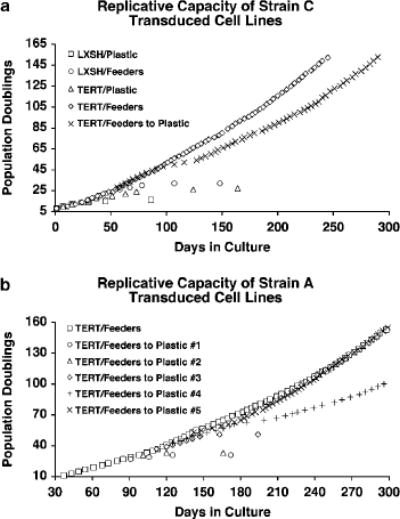Figure 1.

Immortalization of TERT-transduced Strain C and A HFKs co-cultured with feeder cells. (a) Replicative capacities of Strain C HFKs transduced with either LXSH or TERT and cultured on plastic alone (Plastic), in the presence of feeder cells (Feeders), or transferred from the co-culture environment to plastic alone (Feeders to Plastic). TERT/Feeders to Plastic cells were transferred form the co-culture environment to Plastic at PD 26. TERT/Feeders and TERT/Feeders to Plastic HFKs were found to be immortal. The following transduced cell lines senesced at the specified PDs: LXSH/Plastic (~16 PDs), LXSH/Feeders (~32 PDs), TERT/Plastic (~26 PDs). (b) Replicative capacities of Strain A HFKs transduced with TERT and transferred from the co-culture environment to Plastic alone (Feeders to Plastic) at various PDs. TERT/Feeders to Plastic cells were transferred from the co-culture environment to Plastic at the following PDs: PD 25 (#1), PD 29 (#2), PD 35 (#3), PD 41 (#4), PD 51 (#5). TERT/Feeders, TERT/Feeders to Plastic #4, and TERT/Feeders to Plastic #5 HFKs were found to be immortal. The following TERT/Feeders to Plastic cell lines senesced at the specified PDs: ~31 PDs (#1), ~33 PDs (#2), ~49 PDs (#3).
